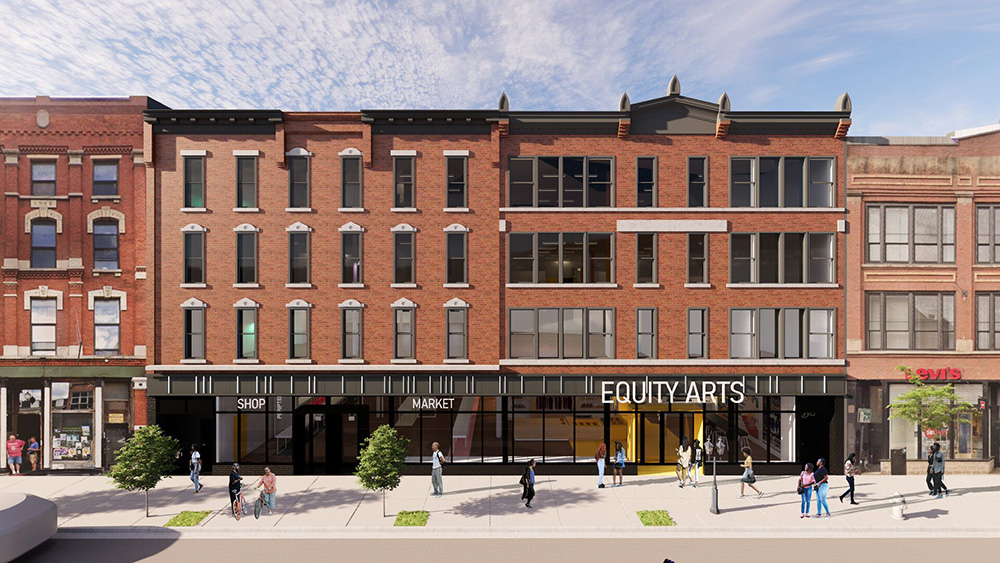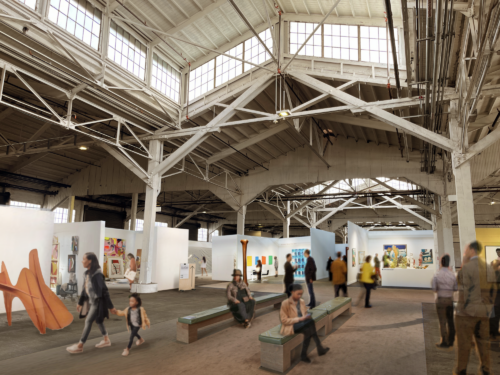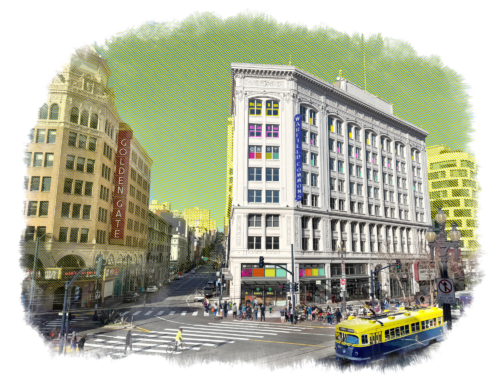Bloomberg CityLab: One Strategy for the Arts to Beat Gentrification: Buy the Building

A rendering of the Lubinski Building as the future home of Equity Arts in Chicago. Courtesy of Future Firm
By Anjulie Rao
As the director of Heaven Gallery in Chicago, Alma Weiser has spent 15 years building a community of emerging artists and curators, showing the work of younger practitioners from marginalized backgrounds and identities. Like many alternative gallery spaces, Heaven provides opportunities to jumpstart an artist’s career. The work is important but financially precarious, particularly when it rubs up against real estate.
In 2019, the building where Heaven and three other DIY venues rent space — a former textiles manufacturer in the booming Wicker Park commercial corridor called the Lubinski Building — went up for sale. To continue the work of stabilizing and supporting artists, Weiser says that she would need to “liberate” the building and its gallery tenants by buying the four-floor, 38,000-square foot space.
“The arts have always been at odds with real estate. Artists create value, we create wealth, and it gets extracted from us and then we have to leave when the neighborhood changes,” Weiser says. “The very thing that creates the value gets ripped out of it.”
But buying a massive building in a booming commercial corridor would be too rich for her blood alone. Weiser needed to raise money. She remembered how she initially got involved in Heaven 15 years earlier: Weiser had been working in fashion design and proposed that the gallery hold a rummage sale with profits shared between her and the gallery. It was a huge success that continued; the gallery “carved out” some space for her from then on, she says.
“[Heaven] was able to support 70% of our annual budget through a vintage shop, which is unheard of for nonprofits,” she explains. But it also sparked her interest in a retail model that funnels money into a nonprofit mission. To buy this building, she’d need a nonprofit and a for-profit enterprise, working together to raise capital. But to preserve the building, she’d need to place it in some type of a trust.
By acquiring the building, Weiser is part of a movement of arts nonprofits that are taking a more direct interest in real estate in order to preserve their communities and livelihoods. In Chicago, San Francisco and Boston, these groups are adopting unique organizational and financial structures to survive in overheated real estate markets. These arts models give artists more control over their place within these neighborhoods, but also emphasize stability and cooperation over resale value.
Heaven Gallery opened in 1997, at a time when cheap rents and abundant square footage enabled young artists to flock to places like Wicker Park. Even as the gentrifying neighborhood has filled with Fluevog and Adidas outlets, Heaven has been able to hang on to its lease in the Lubinski Building, along with other alt-gallery spaces — by now longtime stalwarts. With the sale looming over her head, she founded a new nonprofit organization called Equity Arts that will purchase the building.
“I had to decide whether we were going to disrupt the system, or whether we were going to another neighborhood, displace the working class there, and start the whole cycle again,” Weiser says.
Equity Arts will expand Heaven’s work supporting local artists and curators of color to create economic and cultural opportunities, including creating a new small-business incubator. But the nonprofit’s ultimate mission, Weiser says, is to, “create a new model for arts and culture preservation in rapidly changing communities.” To that end, she hired architects at Future Firm and partnered with P3 Markets, a local developer focused on creating community-based residential and mixed-use projects, to rehab the building into a cohesive arts hub that includes ground-floor retail and performance space, as well as space for gallery tenants (including Heaven and her stalwart colleagues) who will facilitate the exhibitions and programs that meet Equity Arts’ mission.
Weiser found that buying a building as an arts nonprofit isn’t straightforward. There are myriad models for artists and arts organizations to purchase a property, says Juan Saldana, co-founder of P3 Markets, who is helping Weiser build a financial and organizational model. Some might desire to redevelop mixed-use spaces; others might want to purchase studios as a co-operative. Equity Arts, with a focus on entrepreneurship, gathering and exhibitions, chose to use a Perpetual Purpose Trust — a noncharitable LLC — which will allow Equity Arts to pursue philanthropic funds while also operating the building for profit.
“The nonprofit world has wonderful missions, but they don’t have an economic model that’s sustainable over a long period,” Saldana says. “They have to come back and seek funding every year. And many different things change the availability of funding.”
Once Weiser closes on the building, Future Firm founder and architect Ann Lui says they will begin work to bring the building up to code and rehab the basement, first and second floors. Half of the 12,000-square foot first floor, which has been a furniture store since the 1960s, will become an anchor market-rate retail tenant; rent from the tenant, Weiser said, will pay the building’s mortgage and allow grants and philanthropic donations to go further.
With an LLC and 501c3 working in tandem, Equity Arts opens up to other opportunities for funding beyond philanthropy and grants alone. But this is just one model. In San Francisco, the Community Arts Stabilization Trust (CAST) has been assisting local arts organizations to acquire space without the use of PPTs or land trusts. Josh Simon, a senior adviser at CAST, says that, for arts organizations that don’t have access to the capital, the real estate process is “a team sport.” he said. Simon says he helps these organizations assemble the financing pieces — working with community development, philanthropy, financial institutions, or packaging up new market tax credits or historic tax credits — “or any one of the many community development funding sources that we’re familiar with and many arts organizations are not.”
CAST negotiates property acquisition, and invests their dollars into the purchase. After their client reaches stabilization through fundraising and programming, CAST maintains a small ownership percentage over the building to address asset maintenance and management. “It is an incredibly complex and unpredictable journey of time. These things can take five to 10 years on the larger scale projects,” CAST CEO Ken Ikeda says.
Weiser hopes to save Heaven, but she is also passionate about stewarding the future of the Lubinski Building. Equity Arts received a $5 million Recovery Grant from the city last year, which Weiser has leveraged for other private capital alongside philanthropic donations. The PPT deed-restricts the building and requires a governing body that will ensure the building cannot be sold for other types of redevelopment in the future. Governing boards collectively control how profits are reinvested — not only into property maintenance and programming but also into their surrounding communities.
The Ujima Project in Boston uses its governing structure to help local businesses, including artists, to stabilize space and their livelihoods. A Black and artist-led organization advancing collective economics, Ujima operates the nation’s first democratically controlled investment fund, according to executive director Nia Evans. Anyone, with any income, can invest in their fund; residents help craft and vote for a list of businesses that receive investment. Artists are business owners and entrepreneurs, Evans says, and should be part of institutional and financial mechanisms that can protect them from rising real estate costs; some of the new businesses Ujima is ratifying right now include artists seeking space.
“All of us with our different models can be attuned to artists as entrepreneurs and small businesses. There are investment opportunities there,” Evans says.
The model used by Equity Arts, Saldana explains, is a precedent that is designed to prove a theory of value to lenders and funders: Investing in arts-stewarded real estate produces tangible economic value. Commercial funders and lenders don’t typically recognize what makes the arts valuable, like community building and creating neighborhood identity, as providing returns on a balance sheet, he says. Equity Arts is hoping that their model will secure both philanthropic and traditional funding and get to work providing startup businesses with discounted rent, and using net operating income from renting the space for programming or to create new arts grants. Until then, one of the non-commoditized balance sheet items Weiser emphasizes is artist self-determination.
“So often, development happens to us,” Weiser says, “rather than it coming as an organic process of the existing culture developing itself.”




